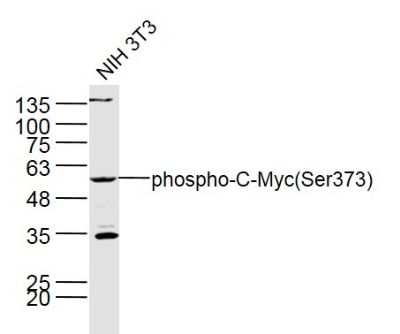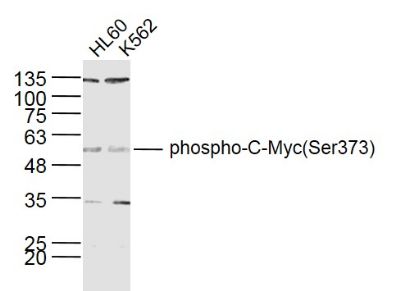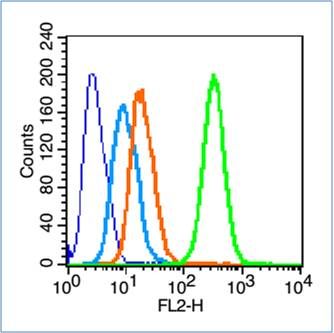产品中心
当前位置:首页>产品中心Anti-phospho-C-Myc(Ser373)
货号: bs-8442R 基本售价: 1580.0 元 规格: 100ul
产品信息
- 产品编号
- bs-8442R
- 英文名称
- phospho-C-Myc (Ser373)
- 中文名称
- 磷酸化致癌基因C-Myc抗体
- 别 名
- Myc(Phospho-Ser373); Myc(Phospho-S373); p-Myc(Ser373); p-Myc(S373); AU016757; Avian myelocytomatosis viral oncogene homolog; bHLHe39; c Myc; Cellular myelocytomatosis oncogene; MGC105490; MRTL; Myc protein; Myc proto oncogene protein; Myc-related translation/localization regulatory factor; Myc2; myca; Myelocytomatosis oncogene a; Myelocytomatosis oncogene; Niard; Nird; Oncogene Myc; Protooncogene homologous to myelocytomatosis virus; RNCMYC; Transcription factor p64; Transcriptional regulator Myc-A; v myc avian myelocytomatosis viral oncogene homolog; v myc myelocytomatosis viral oncogene homolog (avian); V-Myc avian myelocytomatosis viral oncogene homolog; v-myc myelocytomatosis viral oncogene homolog (avian); zc-myc; MYC_HUMAN.
- 规格价格
- 100ul/1580元购买 大包装/询价
- 说 明 书
- 100ul
- 产品类型
- 磷酸化抗体
- 研究领域
- 肿瘤 细胞生物 免疫学 信号转导 转录调节因子 激酶和磷酸酶
- 抗体来源
- Rabbit
- 克隆类型
- Polyclonal
- 交叉反应
- Human, Mouse, Rat, Pig, Cow,
- 产品应用
- WB=1:500-2000 ELISA=1:500-1000 IHC-P=1:400-800 IHC-F=1:400-800 Flow-Cyt=1μg/Test IF=1:50-200 (石蜡切片需做抗原修复)
not yet tested in other applications.
optimal dilutions/concentrations should be determined by the end user.
- 分 子 量
- 49kDa
- 细胞定位
- 细胞核
- 性 状
- Lyophilized or Liquid
- 浓 度
- 1mg/ml
- 免 疫 原
- KLH conjugated synthesised phosphopeptide derived from human C-Myc around the phosphorylation site of Ser373:KR(p-S)F
- 亚 型
- IgG
- 纯化方法
- affinity purified by Protein A
- 储 存 液
- 0.01M TBS(pH7.4) with 1% BSA, 0.03% Proclin300 and 50% Glycerol.
- 保存条件
- Store at -20 °C for one year. Avoid repeated freeze/thaw cycles. The lyophilized antibody is stable at room temperature for at least one month and for greater than a year when kept at -20°C. When reconstituted in sterile pH 7.4 0.01M PBS or diluent of antibody the antibody is stable for at least two weeks at 2-4 °C.
- PubMed
- PubMed
- 产品介绍
- background:
The protein encoded by this gene is a multifunctional, nuclear phosphoprotein that plays a role in cell cycle progression, apoptosis and cellular transformation. It functions as a transcription factor that regulates transcription of specific target genes. Mutations, overexpression, rearrangement and translocation of this gene have been associated with a variety of hematopoietic tumors, leukemias and lymphomas, including Burkitt lymphoma. There is evidence to show that alternative translation initiations from an upstream, in-frame non-AUG (CUG) and a downstream AUG start site result in the production of two isoforms with distinct N-termini. The synthesis of non-AUG initiated protein is suppressed in Burkitts lymphomas, suggesting its importance in the normal function of this gene. [provided by RefSeq, Jul 2008].
Function:
Participates in the regulation of gene transcription. Binds DNA in a non-specific manner, yet also specifically recognizes the core sequence 5-CAC[GA]TG-3. Seems to activate the transcription of growth-related genes.
Subunit:
Efficient DNA binding requires dimerization with another bHLH protein. Binds DNA as a heterodimer with MAX. Interacts with TAF1C and SPAG9. Interacts with PARP10. Interacts with KDM5A and KDM5B. Interacts (when phosphorylated at Thr-58 and Ser-62) with FBXW7. Interacts with PIM2 (By similarity). Interacts with NO66.
Subcellular Location:
Nucleus, nucleoplasm. Nucleus, nucleolus.
Post-translational modifications:
Phosphorylated by PRKDC. Phosphorylation at Thr-58 and Ser-62 by GSK3 is required for ubiquitination and degradation by the proteasome. Phosphorylation at Ser-329 by PIM2 leads to the stabilization of MYC (By similarity). Phosphorylation at Ser-62 by CDK2 prevents Ras-induced senescence.
Ubiquitinated by the SCF(FBXW7) complex when phosphorylated at Thr-58 and Ser-62, leading to its degradation by the proteasome. In the nucleoplasm, ubiquitination is counteracted by USP28, which interacts with isoform 1 of FBXW7 (FBW7alpha), leading to its deubiquitination and preventing degradation. In the nucleolus, however, ubiquitination is not counteracted by USP28, due to the lack of interaction between isoform 4 of FBXW7 (FBW7gamma) and USP28, explaining the selective MYC degradation in the nucleolus. Also polyubiquitinated by the DCX(TRUSS) complex.
DISEASE:
Note=Overexpression of MYC is implicated in the etiology of a variety of hematopoietic tumors.
Note=A chromosomal aberration involving MYC may be a cause of a form of B-cell chronic lymphocytic leukemia. Translocation t(8;12)(q24;q22) with BTG1.
Defects in MYC are a cause of Burkitt lymphoma (BL) [MIM:113970]. A form of undifferentiated malignant lymphoma commonly manifested as a large osteolytic lesion in the jaw or as an abdominal mass. Note=Chromosomal aberrations involving MYC are usually found in Burkitt lymphoma. Translocations t(8;14), t(8;22) or t(2;8) which juxtapose MYC to one of the heavy or light chain immunoglobulin gene loci.
Similarity:
Contains 1 basic helix-loop-helix (bHLH) domain.
SWISS:
P01106
Gene ID:
4609
Database links:Entrez Gene: 4609Human
Entrez Gene: 17869Mouse
Entrez Gene: 24577Rat
Omim: 190080Human
SwissProt: P01106Human
SwissProt: P01108Mouse
SwissProt: P09416Rat
Unigene: 202453Human
Unigene: 2444Mouse
Unigene: 12072Rat
Important Note:
This product as supplied is intended for research use only, not for use in human, therapeutic or diagnostic applications.
- 产品图片
 Sample:
Sample:
NIH-3T3 (Mouse) Lysate at 30 ug
Primary: Anti- phospho-C-Myc(Ser373) (bs-8442R) at 1/300 dilution
Secondary: IRDye800CW Goat Anti-Rabbit IgG at 1/20000 dilution
Predicted band size: 49 kD
Observed band size: 54 kD Sample:
Sample:
HL60 (Human) Lysate at 30 ug
K562 (Human) Lysate at 30 ug
Primary: Anti- phospho-C-Myc(Ser373) (bs-8442R) at 1/300 dilution
Secondary: IRDye800CW Goat Anti-Rabbit IgG at 1/20000 dilution
Predicted band size: 49 kD
Observed band size: 54 kD Blank control (blue line): Hela cells (fixed with 70% methanol (Overnight at 4℃) and then permeabilized with 90% ice-cold methanol for 20 min at -20℃).
Blank control (blue line): Hela cells (fixed with 70% methanol (Overnight at 4℃) and then permeabilized with 90% ice-cold methanol for 20 min at -20℃).
Primary Antibody (green line): Rabbit Anti-phospho-C-Myc(Thr373) antibody (bs-8442R),Dilution: 0.2μg /10^6 cells;
Isotype Control Antibody (orange line): Rabbit IgG .
Secondary Antibody (white blue line): Goat anti-rabbit IgG-PE,Dilution: 1μg /test.

